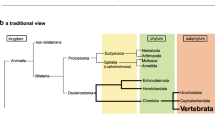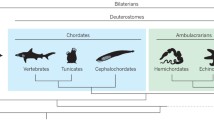Abstract
Embryos of different species of vertebrate share a common organisation and often look similar. Adult differences among species become more apparent through divergence at later stages. Some authors have suggested that members of most or all vertebrate clades pass through a virtually identical, conserved stage. This idea was promoted by Haeckel, and has recently been revived in the context of claims regarding the universality of developmental mechanisms. Thus embryonic resemblance at the tailbud stage has been linked with a conserved pattern of developmental gene expression – the zootype. Haeckel’s drawings of the external morphology of various vertebrates remain the most comprehensive comparative data purporting to show a conserved stage. However, their accuracy has been questioned and only a narrow range of species was illustrated. In view of the current widespread interest in evolutionary developmental biology, and especially in the conservation of developmental mechanisms, re-examination of the extent of variation in vertebrate embryos is long overdue. We present here the first review of the external morphology of tailbud embryos, illustrated with original specimens from a wide range of vertebrate groups. We find that embryos at the tailbud stage – thought to correspond to a conserved stage – show variations in form due to allometry, heterochrony, and differences in body plan and somite number. These variations foreshadow important differences in adult body form. Contrary to recent claims that all vertebrate embryos pass through a stage when they are the same size, we find a greater than 10-fold variation in greatest length at the tailbud stage. Our survey seriously undermines the credibility of Haeckel’s drawings, which depict not a conserved stage for vertebrates, but a stylised amniote embryo. In fact, the taxonomic level of greatest resemblance among vertebrate embryos is below the subphylum. The wide variation in morphology among vertebrate embryos is difficult to reconcile with the idea of a phyogenetically-conserved tailbud stage, and suggests that at least some developmental mechanisms are not highly constrained by the zootype. Our study also highlights the dangers of drawing general conclusions about vertebrate development from studies of gene expression in a small number of laboratory species.
Similar content being viewed by others
Author information
Authors and Affiliations
Additional information
Accepted: 5 April 1997
Rights and permissions
About this article
Cite this article
Richardson, M., Hanken, J., Gooneratne, M. et al. There is no highly conserved embryonic stage in the vertebrates: implications for current theories of evolution and development. Anat Embryol 196, 91–106 (1997). https://doi.org/10.1007/s004290050082
Issue Date:
DOI: https://doi.org/10.1007/s004290050082




